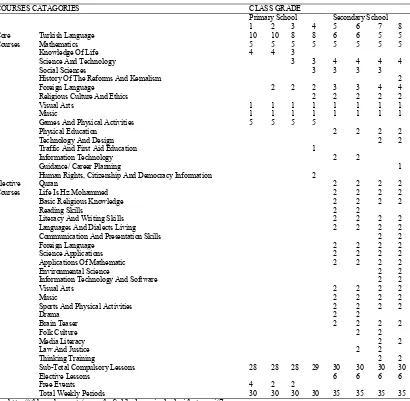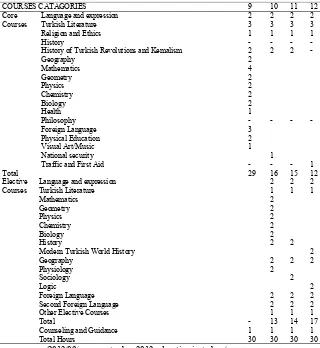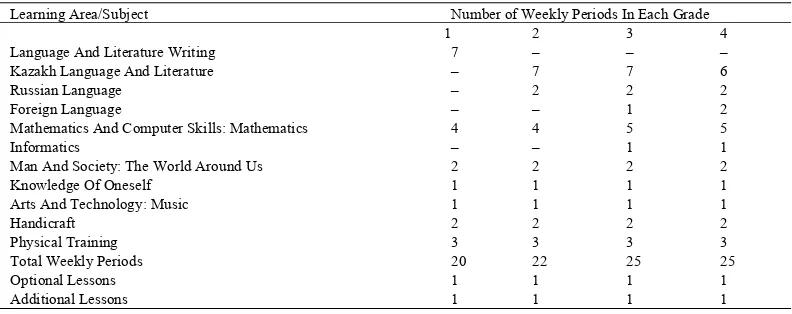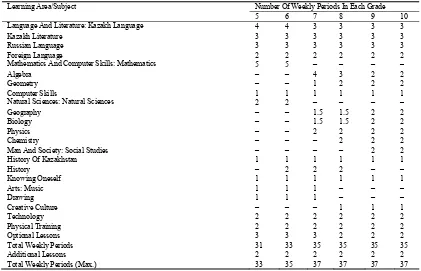Procedia - Social and Behavioral Sciences 197 ( 2015 ) 1827 – 1834
ScienceDirect
1877-0428 © 2015 Published by Elsevier Ltd. This is an open access article under the CC BY-NC-ND license (http://creativecommons.org/licenses/by-nc-nd/4.0/).
Peer-review under responsibility of Academic World Education and Research Center. doi: 10.1016/j.sbspro.2015.07.242
7th World Conference on Educational Sciences, (WCES-2015), 05-07 February 2015, Novotel
Athens Convention Center, Athens, Greece
Comparison Of 12-Year Comsulsory Education In Turkey And
Kazakhsan
Yucel Gelisli
a*, Lyazzat Beisenbayeva
baGazi University Faculty of Education Department of Educational Sciences, Ankara, Turkey bGazi University Education Sciences Institutes Ankara, Turkey
Abstract
The aim of this study is to compare the structure of compulsory education in Turkey and Kazakhstan. The study is descriptive. Laws, legislations, and practices regarding compulsory education in Turkey and Kazakhstan will be analyzed and a comparison between the practices of both will be compared in this study. It took a long time before raising compulsory education to eight years in Turkey. This change is initiated with Primary Education Law, No. 222 entered into force in 1961; however, intermittent education became compulsory in the whole country with the law No. 4306. Reconstruction started after Kazakhstan gained independence and education system was influenced by those changes. After gaining independence, reform movements regarding higher education and compulsory education were initiated. Education was compulsory for 11 years and the school system was formed as general middle education. There are 8573 schools that serve approximately 3 million students. With law No. 861 entered into force in 2006, compulsory education was raised to 11 years. In the same year, compulsory education has been structured as 4+5+2 and pilot studies are planned to be held in the country between 2006 and 2016. Still, there are pilot studies in 107 schools. While compulsory education for 12 years has been adopted for the whole country in Turkey in 2012-2013, pilot studies have started in 2006 in Kazakhstan Republic and it is aimed to generalize the practice to the country based on the results of pilot studies after 2016.
© 2015 The Authors. Published by Elsevier Ltd.
Peer-review under responsibility of Academic World Education and Research Center.
Keywords: Education, Compulsory Education, Duration of Compulsory Education, Compulsory Education Process
1.Introduction
Quality of education and competencies of educated people have been drastically changing in today’s globalized
* Yucel Gelisli Tel: +984530633435 E-mail: [email protected]
© 2015 Published by Elsevier Ltd. This is an open access article under the CC BY-NC-ND license (http://creativecommons.org/licenses/by-nc-nd/4.0/).
world with swift technological developments. This process has led people planning education and human competencies to new fields of search. As international trade has developed, countries have got closer to each other and interaction has begun in every field. Concepts such as international citizenship have emerged with the rise of state unions as in Continental Europe. Accordingly, states have aimed to train their citizens so that they can compete in the globalization process.
Education has been need for every society in every historical period and education has been regarded as a social need in every society because of the fact that education is a process from the perspective of society. The fact that education is regarded as a need by any society in any age (Okutan, 2011; 31) caused education become compulsory for basic citizenship education.
There are two important premises in the recognition of education as compulsory for all people. First one is the formulation of modern state (nation-state) and the other one is modern economy, which is also named as capitalism (Gunduz, 2011; 3). Nations and international unions have happened to plan compulsory education, regarded as basic citizenship education, and competencies in order to enhance human competencies.
The purpose of primary education, one of the levels of compulsory education, is to train “citizens who have shared emotion and values with a wish to live the future together”. From this perspective, the benefit of this level is greater compared to other education levels. That is why, societies put more emphasis on primary education (Aslan,Yildirim, 2013).
In Kazakhstan, education begins with preschool education that starts at the age of 5 and lasts for one year. Students whose ages range between 6 and 10 attend to first level of primary education that covers the first four grades. Basic education covers the period between 5th and 9th grade during which students’ ages range between 10 and 15. Students at the age of 15 and 17 continue with 10th and 11th grades that constitute the last grade of secondary education (www.isaozkan.com).
In order to help all children benefit from the primary education, governments established immediately after the proclamation of the Republic of Turkey, adopted the aim of taking away ignorance with an education policy that aimed ensuring equality of opportunity in education. Primary education became compulsory and public schools were free of charge as stated in Article 87 of 1924 Law (Gelisli, 2005). For a long time, the duration of compulsory education could not be increased in modern societies. Compulsory education was for 3 years in the early years of Turkish Republic and then this period was increased into 5 years which continued for a long time. Besides, an increase in the duration of compulsory education was frequently discussed and The Basic Law of National Education No. 1739 made compulsory education last for 8 years (Guven, 2012; 558).
The concept of basic education that is first put forward by UNESCO in 1950s was used to describe education for adults who had been deprived of education and then the meaning of this concept have changes and it has been used to define education as “education that should be given to citizens by the state with no fee in order to minimize the differences in life stemming from the education of education and uneducated, in our age where learning is necessary for life (Guven, 2012; 559.Okutan, 2011; 33). This made basic education compulsory from the perspective of citizenship education. There are compulsory education models ranging between eight and twelve years in many countries.
1.1.Aim
The aim is to make a structural comparison between the practices of compulsory education in Turkey and Kazakhstan. Based on this primary aim, answers are searched for the following questions:
In the primary and secondary compulsory education practices in Turkey and Kazakhstan; 1. How are the weekly timetables arranged?
2. What is the expansion of compulsory education? 3. What is the structure of compulsory education programs? 4. What are the problems encountered in practice?
2.Method
phenomenon of research (Yildirim, Simsek, 2008). Data was analyzed and interpreted via descriptive analysis technique. Descriptive analysis is a qualitative analysis technique used for data that do not require for deep analysis (Yildirim ve Simsek, 2008).
3.Findings
This section describes the results obtained in the study.
3.1. Regulations related to compulsory education in Turkey and Kazakhstan
Turkey enacted "Temporary primary law" in 1915 that led primary education become compulsory and free in the public schools. Regulations’ regarding compulsory education were made in the later years of the Republic (Gelisli; 2005).
The Primary Education and Training Law No. 222 regulated primary education as a complete system on 12.1.1961. The Basic Law of National Education No. 1739 entered into force on 24 June 1973 and as amended by Law No. 2842 re regulated on 16.6.183 and by Law No. 4306 of 18 August 1997, covers the following aspects of the education system: general and specific objectives; basic principles; general structure; institutions and establishments of all types and levels; teaching staff; school buildings and facilities; educational materials and equipment; and duties and responsibilities in the field of education and training. The Apprenticeship and Vocational Training Law No. 3308 of 5 June 1986 was adopted in order to improve the vocational and technical training system. It was amended as Vocational Education Law by the Law No. 4702 (Gelisli, 2005. Unesco, 2011-2012. www.mevzuat.meb.gov.tr).
According to 1982 Constitution, basic education is compulsory for all individuals and free in state schools. Turkish compulsory education (Basic Education) has a structure that corresponds to primary (4) and lower secondary education (4) and secondary education (4). This education is based on the concept 4+4+4 format which has been in use since 2012. As of 2012 September, the compulsory education 12 years consisting of three consecutive periods of 4 years (webgate.ec.europa.eu, kre.wes.org. OECD, 2013; 4).
On the other hand, the Republic of Kazakhstan is creating the new legal base of the education system since independence. The two main laws regulating education in the country are the Law on Education of 7 July 1992 and the Law on Higher Education of 1993. These laws determine the State educational policy, the objectives and principles of education, the administrative structure, and the system of private schools. The Law on Education provides for the following levels of education: preschool, secondary, vocational and technical secondary, higher and postgraduate education. Secondary education consists of three stages: elementary (four year’s program), basic secondary (five years) and senior secondary (two years). As secondary education has become compulsory and students completing 9th grade are prepared for vocations according to the Law on Education, this increase their chances of finding jobs in different foundations (Unesco, 2011-2012. kre.wes.org. Savas, 2010; 276).
Analysis of the systems in Turkey and Kazakhstan reveals that compulsory education is 12 years in Turkey while it is 11 years in Kazakhstan. However, compulsory education is planned to be increased to 12 years in Kazakhstan and pilot studies have been carried out. The levels of compulsory education practices are presented in the following table:1
Table 1. The System of Compulsory Education of Turkey and Kazakhstan.
Table 1 shows that compulsory education in Turkey is composed of elementary school, secondary school and high school, each of whom lasts for four years while in Kazakhstan there are different levels in compulsory education. Compulsory education in Kazakhstan consists of an 11-year secondary school. However, in this structure, there are different levels named as elementary (four year’s program), basic secondary (five years) and senior
Educational Level Turkey Kazakhstan
Primary School 4 4
Secondary School 4 5
High School 4 2
secondary (two years) education.
3.2. Turkey Compulsory Education System
Turkey Primary Education Institutions:
The compulsory primary school age ranges from 6 to 13. The enrollment of this age group starts at the end month of September when child completed the age of 5, and finishes at the end of the educational year when child completed 13 and begins the age of 14 (MEB,2012).
The objective of primary education is to ensure that every Turkish child acquires the necessary knowledge, skills, behavior and habits to become a good citizen and is raised in accordance with the concept of national morals and that he/she is prepared for life and for the next level of education in accordance with his/her interests, talents and capabilities (UNESCO-IBE, 2010-2011).
Table 2: Turkey Primary Education: Weekly Lesson Timetable
COURSES CATAGORIES CLASS GRADE
History Of The Reforms And Kemalism 2
Foreign Language 2 2 2 3 3 4 4
Traffic And First Aid Education 1
Information Technology 2 2
Guidance/ Career Planning 1
Human Rights, Citizenship And Democracy Information 2 Elective
Communication And Presentation Skills 2 2
Foreign Language 2 2 2 2
Science Applications 2 2 2 2
Applications Of Mathematic 2 2 2 2
Environmental Science 2 2
Information Technology And Software 2 2
Primary education institutions consist of the four year and compulsory lower secondary schools four year and compulsory lower secondary schools which give opportunity to allow between different programmers, and lower secondary schools for imams and preachers. The preferable lessons in type of supporting students’ upper secondary education are consist of by students’ ability, improvement and prefers in lower secondary schools and lower secondary schools for imams and preachers (UNESCO-IBE, 2010-2011).
The curriculum includes compulsory subjects and a number of lessons/periods that are decided at the school level depending on the conditions of school and local environment, students’ interests, needs and aspirations, and parents’ opinions. Schools may also decide to increase the number of elective lessons with the MONE approval. In grades 4-8 one of the electives can be foreign language instruction, either for reinforcing the compulsory foreign language or for introducing a second foreign language. Foreign language instruction can also be offered in all grades as extracurricular time (UNESCO-IBE, 2010-2011). The table below shows the weekly lesson timetable of primary education in 2012-2013:
Normally, in grades 1 to 4 one classroom teacher teaches all the subjects, while in grades 5 to 8 there are subject teachers. For some subjects such as music, physical education, and foreign language it is possible to employ subject teachers after grade 4. Educational methods are determined by teachers on the basis of the existing curriculum and syllabus. Teaching aids are selected by teachers and approved by the school principal. Primary education textbooks are approved by the MONE and distributed to all pupils free of charge.
Table 3: Turkey Upper Secondary (High School) Education: Weekly Lesson Timetable
Total 29 16 15 12
Modern Turkish World History 2
Geography 2 2 2
Upper Secondary Education: Prescribed by the Law No. 6287 , " Secondary education on primary education,
four years of compulsory, formal or non-formal education, which generally covers all of the vocational and technical education institutions. Upper Secondary school based on primary and lower secondary education. This is given to secondary school diploma graduates (webgate.ec.europa.eu). The aims and duties of secondary education, in accordance with the general purposes and basic principles of National Education, are as follows (MEB, 2013; XIII);
1. Enabling all students to have the awareness and power to get to know the problems provided that giving culture on minimum common general level look for ways of solution and acquire the conscious of contributing to country’s economical, social and cultural development and power.
2. Preparing students for higher education or for life and job fields in accordance with their interests, aptitude and abilities with various programs and schools. While these missions are accomplished, a balance is set between students’ expectations and abilities and the needs of the society.
Secondary education is provided in general high schools of different types (i.e. general high schools, Anatolian high schools, science high schools, Anatolian teacher training high schools, Anatolian fine arts high schools, and social sciences high schools) and at least 19 different kinds of vocational and technical high schools which provide training in more than 130 occupations leading to the qualification of specialized worker and technician (UNESCO-IBE, 2010-2011).
General Secondary Education: It is a four-year compulsory educational process that prepares students both for higher education and for the future according to their interests, expectations and abilities in addition to equipping them with world knowledge with an education based on primary education (MEB, 2013; XIII).
Vocational and Technical Secondary Education: It is a four-year compulsory educational process that prepares students both for higher education and for the future as well as for an occupation and job fields according to their interests, expectations and abilities in addition to equipping them with world knowledge with an education based on primary education(MEB, 2013; XIV).
3.2. Kazakhstan Compulsory Education System
Kazakhstan Primary Education: Basic regulations related to Kazakhstan's education system were made in 1992. The Education Law, adopted in 1992, established the new principles and objectives of education. In accordance with Article 3, the basic principles of education in the country are the following: equality of citizens in their right to receive education; diversification of educational institutions in terms of ownership, direction of activities, forms of education and training; continuity in the process of education; scientific and secular character, and ecological orientation of education in state educational institutions; democracy in the management of the education system.
Elementary education lasts four years and is the first stage of compulsory education. It is possible to enter school at the age of 6 by passing entrance tests, but the majority of children enroll at the age of 7. The main objectives of primary education are to teach children to read and write, to develop basic skills in numeracy and simple arithmetical operations, and to teach the elementary basis of social and natural disciplines.
The lesson timetable for primary education (2008) is shown in the table below:
Table 4: Kazakhstan Primary Education: Weekly Lesson Timetable
Learning Area/Subject Number of Weekly Periods In Each Grade
1 2 3 4
Language And Literature Writing 7 – – –
Kazakh Language And Literature – 7 7 6
Russian Language – 2 2 2
Foreign Language – – 1 2
Mathematics And Computer Skills: Mathematics 4 4 5 5
Total Weekly Periods (Max.) 22 24 27 27
Schools are free to define their own program as far as additional and optional lessons are concerned. Upon completion of primary education, pupils are admitted to grade 5. In some schools there are examinations in Kazakh or Russian language and mathematics.
Secondary education :The main purposes of secondary education are: to lay down a common cultural and scientific basis through the compulsory general education program; to facilitate the social adaptation of students to life in the community; to develop the sense of citizenship and love of Motherland; and to provide the national community with qualified workers and specialists
Secondary education consists of two levels: basic (five years’ duration) and senior secondary (two years’ duration). Students completing basic secondary education and having passed the final examination receive a certificate. Students completing senior secondary and having passed the final examination receive the certificate of complete secondary education. Students can enter technical and vocational schools after completing basic secondary (grade 9) for a three- to four-year training program, or with complete secondary (grade 11) for a training program lasting two to three years. Secondary education is free and in principle compulsory. The transition to a twelve-year education system (e.g. primary education covering grades 1-4; basic secondary, grades 5-10; and secondary education or profile training, grades 11 and 12) is expected to be completed by 2015. The lesson timetable for general secondary education (2008) is shown below:
Table 5: Kazakhstan Upper Secondary (High School) Education: Weekly Lesson Timetable
Learning Area/Subject Number Of Weekly Periods In Each Grade
5 6 7 8 9 10
Source: Ministry of Education and Science, State Standards for Secondary Education (2008), 2009.
4.Conclusion
From the data obtained in this study removed the following results;
2. Both countries have aimed increasing the standards of compulsory education as in developed countries and have put plans into place.
3. Compulsory education was increased from 8 to 12 years in Turkey, while it was increased to 11 years in Kazakhstan. The education system is structured as 4+4+4 in Turkey while it has the structure of 4+5+2 in Kazakhstan.
4. The regulations were put into practice in Turkey in 2012 while pilot studies have still been carried out in Kazakhstan where debates about the duration of compulsory education continue.
References
Aslan, B.,Yildirim, N.(2013). Cumhuriyetimizin Kurulus Felsefesinin Ongordugu Egitim Acisindan Ilkogretim. Akademik Bakis, 34, 1-18. EURYDICE. National system overview on education systems in Europe: Turkey. European Commission, 2011 edition, November 2011. Gelisli, Y. (2005). Turkiye' de Ilkogretimin Gelisimi. Ankara: Sistem Ofset.
Gunduz, M.(2011).Zorunlu ve Kesintisiz Egitimin Kisa Tarihi. Egitime Bakis,21,3-11.
Guven,I.(). The 4+4+4 School Reform Bill and the Fatih Project: is It a Reform?, Elementary Education Online, 11(3), 556-577, 2012. http://ilkogretim-online.org.tr
National Education Statistics, Formal Education 2013/'14
OECD (2013), Education Policy Outlook: Turkey, http://www.oecd.org/edu/education%20policy %20outlook%20 turkey_en.pdf Okutan, M.(2011). Sekiz Yillik Kesintisiz Zorunlu Ilkogretim Uygulamasi. Egitime Bakis,31-36.
Ozkan, I. Bagimsizliklarinin On Besinci Yilinda Turk Cumhuriyetlerinde Egitim ve Sosyal Degisme. http://www.isaozkan.com/dosyalar/Bagimsizliklarinin-15-Yilinda.pdf
Savas,S.(2010). Turk Dunyasinda Egitim Alanindaki Gelismeler Ve Yenilikler Journal of Azerbaijani Studies, jhss-khazar.org/wp-content/uploads/2010/06/21.pdf
T. C. MEB.(2012). 12 Yil Zorunlu Egitim Sorular – Cevaplar, Ankara. T.C. Resmi Gazete. (1961, 1 12). Resmi Gazete , s. 1460.
T.C. Resmi Gazete. (1997, 8 18). 4306 Sayili Kanun. Resmi Gazete .
T.C. Resmi Gazete. (2012, 4 11). Ilkogretim ve Egitim Kanunu ile Bazi Kanunlarda Degisiklik UNESCO-IBE (http://www.ibe.unesco.org/) World Data on Education. 7th edition, 2010/11 http://kre.wes.org/acton/fs/blocks/showLandingPage/a/4184/p/p-0030/t/page/fm/9 http://mevzuat.meb.gov.tr/html/temkanun_0/temelkanun_0.html
https://webgate.ec.europa.eu/fpfis/mwikis/eurydice/index.php/Turkey:Overview
https://webgate.ec.europa.eu/fpfis/mwikis/eurydice/index.php/Turkey:Upper_Secondary_and_Post-Secondary_Non-Tertiary_Education http://wenr.wes.org/2012/09/wenr-september-2012-education-in-turkey/
http://ttkb.meb.gov.tr/www/haftalik-ders-cizelgeleri/kategori/7




